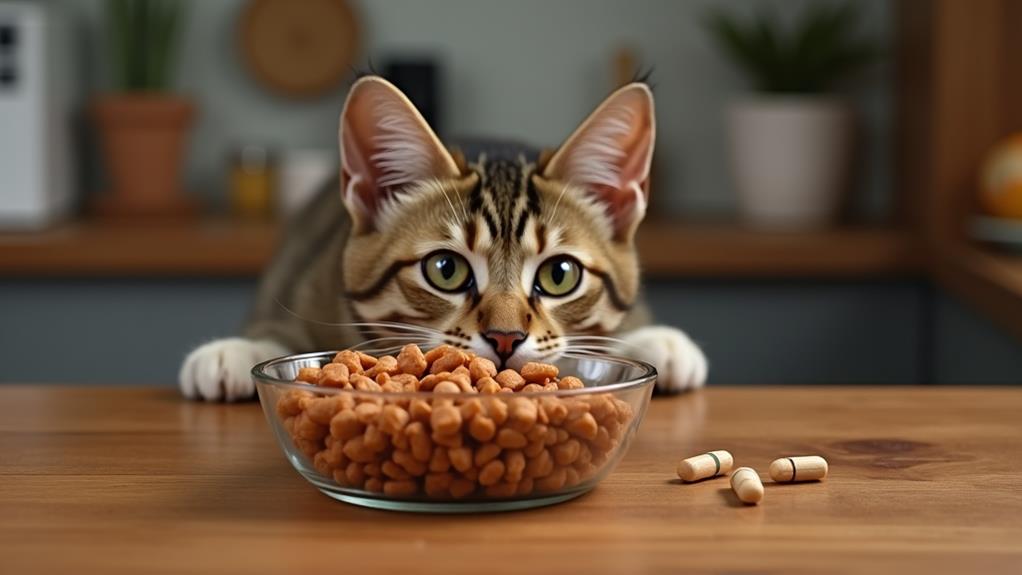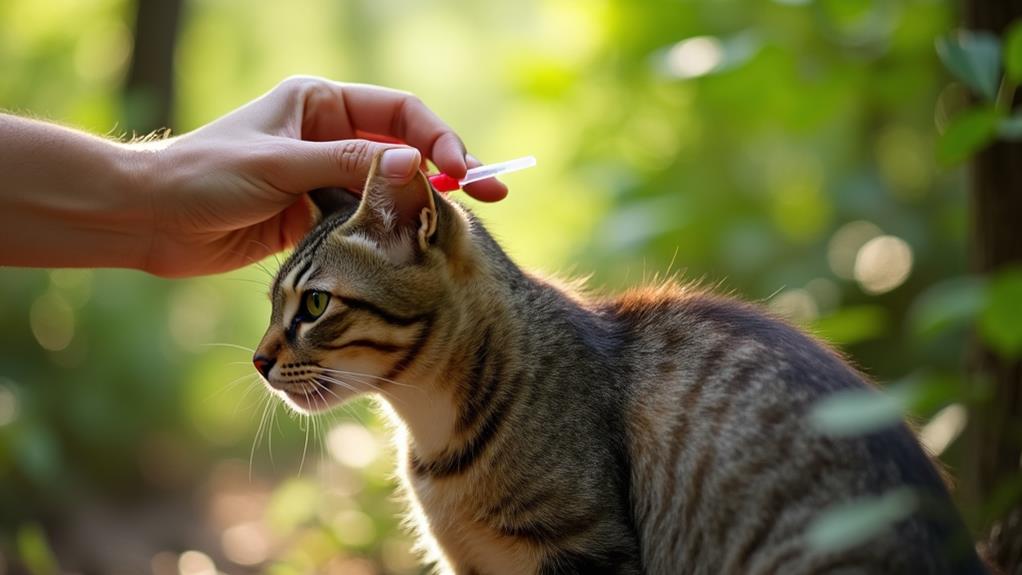How to Worm a Feral Cat: Simple Methods for Deworming

To deworm a feral cat, start by choosing effective medications like Panacur or topical treatments such as Drontal Spot-On. Mix the medication with food or milk replacer to guarantee they consume it, especially if dealing with kittens who start deworming at 3-4 weeks. Consider adding food-grade diatomaceous earth to their diet. Tackle any behavioral challenges by using humane traps and positive reinforcement. Regularly monitor their health post-treatment for signs of improvement like increased energy. It's vital to regularly visit a vet for tailored advice. There are fundamental strategies and best practices that improve success in deworming feral cats.
Understanding Feral Cat Worms
Feral cats often face the challenge of intestinal parasites, which can seriously impact their health and well-being. In feral cat colonies, these parasites, such as roundworms, tapeworms, and hookworms, are quite common and can spread rapidly. Roundworms are particularly prevalent, causing symptoms like weight loss, rough coats, and nutritional deficiencies. They feed directly on the cat's nutrients, leaving the animal weakened and less capable of thriving in its environment. This is a serious concern in feral cat colonies where resources are already scarce.
Tapeworms, on the other hand, are primarily transmitted through fleas, which means that effective flea control is vital in managing these infestations. In feral cat colonies, where flea infestations can be widespread, tapeworms can quickly become a problem if not addressed. Hookworms also pose significant risks, especially to those cats that roam outdoors, which is typical behavior in feral cat colonies. These parasites can cause severe health issues if left untreated.
Kittens in these colonies require particular attention with a deworming schedule starting at 3-4 weeks of maturity. Regular treatments every two weeks until they reach six months guarantee they grow healthy and parasite-free.
Effective Deworming Medications
In regard to keeping feral cats healthy, choosing the right deworming medication is essential. Effective deworming medications like Panacur (fenbendazole) tackle a variety of parasites, including roundworms, hookworms, tapeworms, and giardia. You'll typically administer Panacur once daily for three consecutive days, guaranteeing a thorough approach to parasite management. This makes it an excellent choice for maintaining the health of feral cats.
If you're dealing with feral cats, topical options such as Drontal Spot-On and Profender offer convenient alternatives. These medications are applied directly to the skin, effectively treating worms while also providing protection against fleas and ticks. Topical solutions can be particularly useful if a feral cat is resistant to oral treatments.
For kittens, it's essential to follow a specific deworming schedule. Start treatment at 3-4 weeks old, administering dewormers every two weeks until they reach six months, then continue with monthly treatments. This routine guarantees young cats remain worm-free during their significant growth period. Always consult a veterinarian before selecting deworming products for feral cats to guarantee safety and effectiveness. Their guidance will help you choose the best path for keeping these felines healthy.
Administering Medication With Food

Choosing the right medication is just the beginning; guaranteeing it gets consumed effectively is just as crucial. When you're deworming feral cats, administering medication with food can be a practical solution. By mixing deworming medication like Panacur (fenbendazole) with food, you increase the likelihood that the cats will ingest the entire dose. This method works particularly well with liquid or granule forms of the medication.
For the best results, create a slurry by adding water to the food. This consistency makes it more appealing to feral cats, even the pickier ones. Be sure to use separate feeding plates for each cat. This way, you can monitor individual dosages accurately. It's recommended to add about one heaping teaspoon of a food-grade diatomaceous earth (DE) blend per cat, which aids in the deworming process.
After administering medication with food, keep a close eye on the cats' health and energy levels. Regular monitoring will help you determine the effectiveness of the treatment. This approach guarantees that each feral cat gets the right amount of medication, making the deworming process more efficient and successful.
Using Milk Replacer for Kittens
When deworming feral kittens, using milk replacer is an effective strategy to confirm they consume their medication. The palatable taste of milk replacer can easily mask the often unpleasant flavor of deworming medication, making it more likely that the kittens will ingest their full dose. Begin by introducing the kittens to unmedicated milk replacer initially. This helps build trust and guarantees they're accustomed to the taste and texture before you mix in any medication.
Once the kittens are comfortable with the milk replacer, you can mix the prescribed deworming medication with it. Accurate dosing is essential, so make certain to calculate the total number of kittens in the colony. Each one should receive the correct amount of medication to confirm effective treatment. Start treating them every two weeks starting at 3-4 weeks old, and continue monthly until they reach 6 months. Afterward, you can adjust to a schedule of every 1-3 months.
Regularly monitor the kittens' health following each treatment. This will help you assess the effectiveness of the deworming process and make necessary adjustments for future treatments. With careful attention, you can help these feral kittens stay healthy.
Applying Topical Dewormers

Applying topical dewormers is a practical and stress-free method to treat feral cats. Products like Drontal Spot-On and Profender are effective because they're applied directly to the skin, eliminating the need for oral administration. They offer extensive protection against multiple parasites, such as fleas, ticks, and intestinal worms, guaranteeing thorough care. When applying these treatments, take care to use the correct dosage based on the cat's weight. Overdosing can lead to adverse effects, so precision is essential.
To guarantee a successful application, follow these guidelines:
- Prepare a calm environment: A stress-free setting reduces the chance of the cat resisting or escaping.
- Check the cat's weight: Accurate dosing is significant to avoid potential harm.
- Apply correctly: Follow the instructions carefully, ensuring the product reaches the skin.
- Use gloves: Protect yourself from accidental exposure to the treatment.
- Monitor regularly: After application, observe the cat to assess effectiveness and watch for any side effects or allergic reactions.
Applying topical dewormers requires attention to detail and care, but with these steps, you can effectively manage parasites in feral cats while minimizing stress for both of you.
The Role of Veterinary Visits
While topical dewormers offer a practical solution for managing parasites, veterinary visits play an indispensable role in guaranteeing the thorough health of feral cats. A veterinary visit allows for a meticulous examination to spot not only parasites but also other potential health issues. Vets can assess the specific types of worms affecting the cat and recommend the most effective deworming products tailored to their health status.
During these visits, a vet can also identify any underlying health problems that may worsen due to parasitic infections, such as a weakened immune system. Regular check-ups are essential for catching these issues early, guaranteeing cats receive the best care possible. Furthermore, a veterinary visit allows for simultaneous treatment of other health concerns, maximizing the benefits of each appointment and providing extensive care.
Veterinary guidance is especially significant for kittens. Establishing a deworming schedule is necessary, as kittens should start deworming at 3-4 weeks old and continue monthly until they're six months old. This proactive approach helps guarantee they grow into healthy adults. Consequently, making veterinary visits a part of your feral cat care routine is key to their holistic well-being and longevity.
Overcoming Behavioral Challenges

Dealing with feral cats' natural wariness presents unique challenges, especially when trying to administer deworming treatments. Overcoming behavioral challenges requires a thoughtful approach. One cat might be more skittish than another, so patience is key. Start by providing a calm and quiet environment to help minimize the cat's anxiety. Fear and stress can make them resist treatment, so create a secure space where they feel safe.
- Use a feeding schedule to establish a routine. Cats are more likely to approach food when they expect it.
- Consider mixing deworming medication with their favorite food. This increases the likelihood they'll ingest the medicine without realizing it.
- Employ humane traps to prevent escape. These allow you to administer medication without direct contact, reducing stress for both you and the cat.
- For kittens, use milk replacer mixed with medication. It's often more palatable and easier for them to consume.
- Monitor their behavior closely. Notice any signs of distress and adjust your methods accordingly.
Monitoring Health Post-Treatment
After successfully deworming a feral cat, it's essential to monitor their health closely to guarantee recovery. Start by looking for signs of improved health like increased energy levels, a better appetite, and an improved coat condition. These changes should become noticeable within a week post-treatment. Keep a vigilant eye on any lingering symptoms such as weight loss, vomiting, or diarrhea. If you observe these, it might be necessary to take the cat to the vet for further evaluation.
Create a health log for each cat. Document any changes and behaviors post-treatment. This record helps assess the effectiveness of your deworming method and provides vital information if you need to consult a vet. Weigh the cats periodically. Gaining weight is a positive indicator of recovery from parasitic infections, as it signals nutritional replenishment.
Observe how they interact with other cats in the colony. Any signs of distress or illness might suggest ongoing health issues needing attention. Consistent monitoring health post-treatment guarantees that your efforts in deworming are successful and that the cats return to a healthy state. Always be prepared to seek veterinary care if needed.
Community Support and Programs

Engaging with community support and programs is important in managing feral cat populations effectively. Many communities have established initiatives focused on spaying/neutering and deworming feral cats to improve their health and control overpopulation. As a community member, you can tap into these resources to aid in deworming efforts. Local animal shelters and rescue organizations often provide valuable support, making it easier for you to contribute to the well-being of these cats.
Community outreach efforts play a vital role in educating the public about the significance of deworming feral cats. By understanding how this process contributes to better comprehensive colony health, you can make informed decisions and participate actively. Collaborative programs often involve veterinary professionals who offer guidance and necessary services, ensuring successful deworming and health monitoring.
Consider joining or supporting community programs to improve the welfare of feral cat colonies and reduce the risk of parasites spreading to domestic pets. Here's how you can get involved:
- Attend community workshops or informational sessions.
- Volunteer at local shelters or rescue organizations.
- Share educational materials within your community.
- Donate supplies or funds to support these programs.
- Advocate for community support initiatives in your local area.
These efforts collectively make a significant impact on feral cat colonies.
Ensuring Product Safety and Availability
When considering deworming options for feral cats, guaranteeing product safety and availability is fundamental to effective care. You'll want to investigate safe, effective choices like food-grade diatomaceous earth (DE). It's readily available at farm stores and online, but always make certain it's the correct grade to prevent any harmful effects. Choosing the right products means consulting with a veterinarian to confirm they're safe for feral cats. This step is critical for maintaining product safety and avoiding unexpected health issues.
Monitoring product availability is also significant since some deworming medications might not be consistently stocked. Keeping track of availability guarantees you're prepared with alternative solutions if needed. For instance, if you're deworming kittens, a half teaspoon of food-grade DE blend is recommended. Adjusting dosages according to the cat's maturity and size is key to safe and effective treatment.
Beyond deworming, using food-grade DE can improve general health indicators like coat condition and weight gain, making it a beneficial supplement to the diet. By prioritizing product safety and monitoring availability, you're effectively supporting the health and well-being of feral cats in your care.




